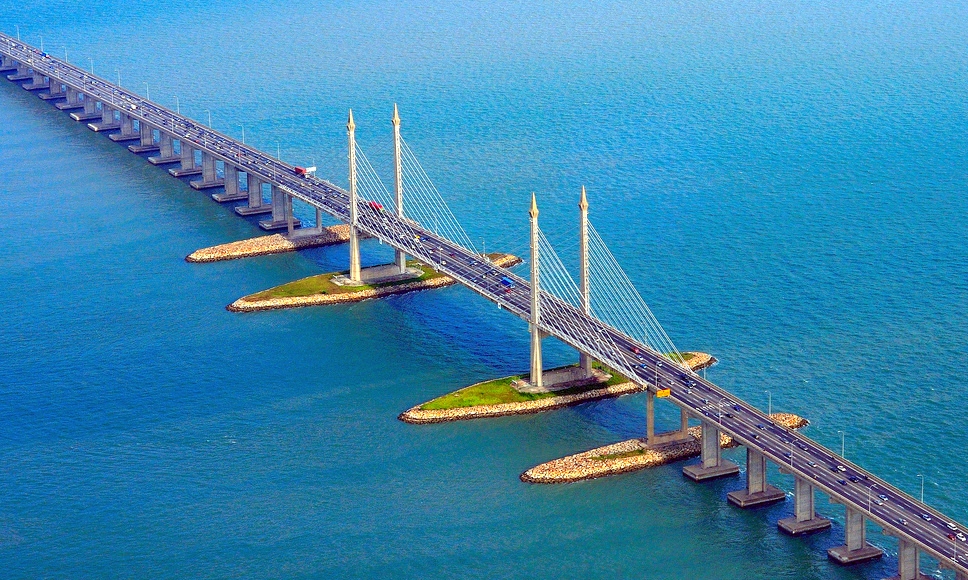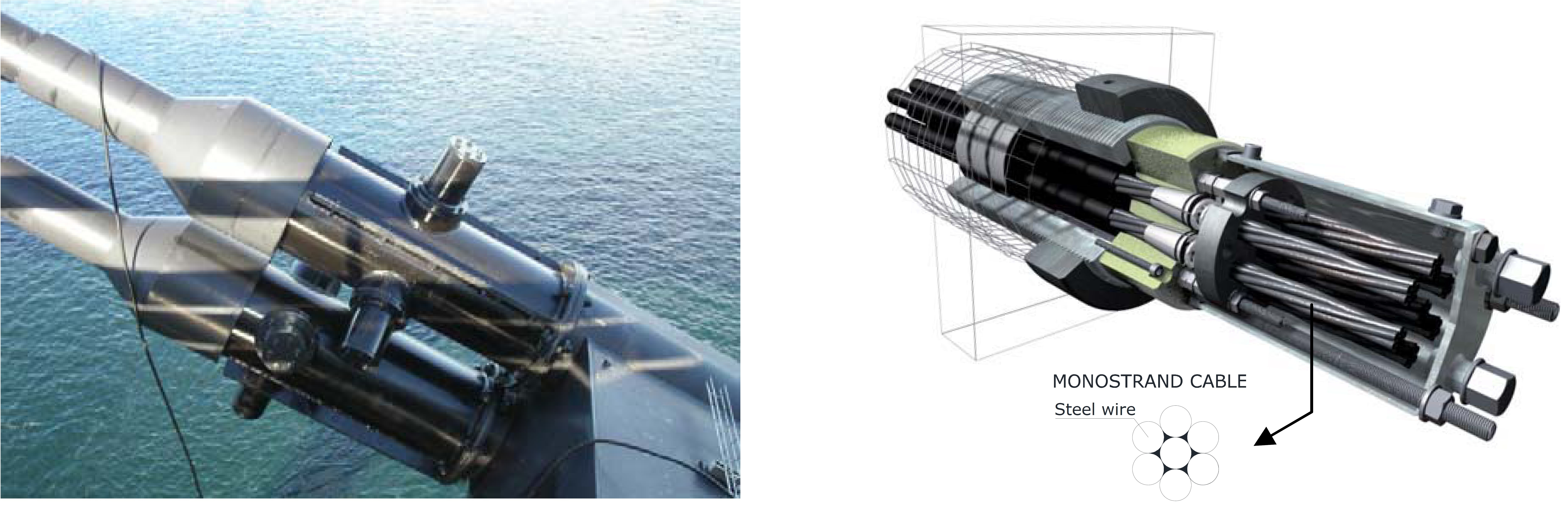Article No. 15
Industrial Ph.D. Project (April 2011 - March 2014)
Student: Jan Winkler
Supervisors: Christos T. Georgakis ; Gregor Fischer
Industry partner: ATKINS A/S
Background and Motivation:
For many cable-stayed structures, high strength steel cables are the preferred tensile load bearing structural element as they are by far the least expensive per unit tensile force. Cable stays support many telecommunication masts, stadiums, bridges and offshore platforms. In many cases, these stays are exposed to wind, waves or water currents that can generate large amplitude vibrations both in the stays and in the supported structures. Cables with their flexibility and low structural damping are particularly susceptible to different types of vibrations that may lead to cable fatigue failures near the anchorage.
Cable fatigue led to a number of major stay cable replacement projects that have been completed over the past ten years. Examples of bridges with a history of cable replacement include the Guazu Bridge, the Chaco–Corrientes Bridge, the Luangwa Bridge, the Halle Boggs Bridge, the Rhine River Crossing and the Penang Bridge (Fig.1). The cable failure occurs predominantly near the cable anchorage where the combination of the deterioration, fatigue and bending stresses induced by vibrations may cause significant overstress of the cable. However, in case of the parallel-bar stay cable systems where cables comprise lengths of coupled high-yield bars fatigue damage may also occur along the cable’s length.

Figure 1: Penang Bridge in Malaysia.
Different criteria have been proposed in literature to evaluate cable fatigue damage. The problem of cable axial fatigue has been previously investigated However, limited work has been undertaken to thoroughly assess the fatigue characteristics of the various types of bridge cables subjected to cyclic transverse deformations as cables are in principle not expected to experience bending. Although the problem of cable bending fatigue has also been studied, there are still unresolved issues that need clarification and some aspects of these form the basis of the present project. It was reported that the current approaches and the fatigue models do not give sufficiently accurate results and the methods seeking to evaluate the cable’s fatigue strength should be developed further to be consistent with observed fatigue failures for cables subjected to transverse deformations.
To date, only several experimental investigations of stay cable fatigue behavior under bending have been carried out. In most cases, bending stresses at the anchorage corresponding to the applied angular deviations were not measured.
As the majority of modern stay cables used in cable stayed structures are comprised of a number of individual high-strength steel monostrands (Fig.2), investigations of the bending fatigue performance of individual monostrand have become more relevant.

Figure 2: Stay cable anchorage of the Oresund Bridge (left) and an example of similar parallel monostrand stay cable anchorage (right)
Moreover, the commonly applied qualification tests for the fatigue resistance of stay cables, as outlined in fib and PTI , do not specifically address fatigue issues related to transverse cable vibrations and therefore do not require testing for bending. As a consequence of this, high-strength steel cable bending fatigue spectra have not yet been developed. Thus, the calculation of the fatigue lifetime of stay cables is currently only possible for axial variations in stresses.
Summary:
The objective of the proposed research is firstly, the extension of mono-strand bending fatigue tests undertaken at DTU Byg, to enhance the reliability and improve the resolution of the existing spectrum. Secondly, a localised bending fatigue behavior of high-strength steel mono-strands will be studied in detail to investigate fatigue induced failure modes of a mono-strand cables. Thirdly, a relationship between the fatigue resistance of a mono-strand and a full parallel mono-strand stay cable would be made, through mathematical modelling and full-scale static testing. The proposed research should lead to a simplified model that can be used for the assessment of stay cable fatigue.
With this research, it is hoped that one of the most basic oversights in the lifetime assessment of cable-supported structures, namely the bending fatigue resistance of parallel mono-strand cables, will be addressed.
Ongoing Research Work:
Summer 2011:
At the moment work is focused a detailed literature study related with cable bending fatigue. The literature is reviewed parallel with preparations for the experimental work at the laboratory of the Civil Engineering Department Byg DTU. Additional bending fatigue tests at lower stress ranges are planned to be conducted. Moreover, tensile test on monostrand will be performed with the use of a high-speed camera and ARAMIS photogrammetric software. The possible interwire movement captured by the camera shall be related with the measurements obtained from strain gauges attached to the individual wires.
Related Publicaitons:
Submitted:
Winkler J., Fischer G., Georgakis C., Kotas A., “A Preliminary Bending Fatigue Spectrum for Steel Monostrand Cables”, 35th International Symposium on Bridge and Structural Engineering IABSE-IASS 2011, London, 20-23 September 2011 (full conference paper)
Winkler J., Georgakis C., "Bridge Stay Cable Replacement Projects: A Review", 9th International Symposium on Cable Dynamics ISCD 2011, Shanghai, 18-20 October 2011 (abstract)
In Preparation:
Winkler J., Fischer G., Georgakis C., “Localised Bending Fatigue Behavior of a High-strength Steel Monostrands”, 6th International Conference on Bridge Maintenance, Safety and Management IABMAS 2012, Lake Como, Italy, 8-12 July 2012 (full conference paper)
References related to this Research Project:
[1] HOBBS R.E., GHAVAMI K., “The fatigue of structural wire strands”, International Journal of Fatigue, Vol. 4, pp. 69–72, 1982
[2] HOBBS R.E., SMITH B.W., “Fatigue performance of socketed terminations to structural strands”, In: Proc. Institution of Civil Engineers. Part 2. Research and theory, Vol. 75, pp. 35–48, 1983
[3] HOBBS R.E., RAOOF M., “Behaviour of cables under dynamic or repeated loading”, Journal of Constructional Steel Research, Vol. 39, pp. 31–50, 1996
[4] CREMONA C., “A short note on cable fatigue”, In: Proc. 5th international symposium on cable dynamics, 2003
[5] CLUNI F., GUSELLA V., UBERTINI F., “A parametric investigation of wind-induced cable fatigue”, Engineering Structures, Vol. 29, pp. 3094-3105, 2007
[6] JENSEN J.L., BITSCH N., LAURSEN E., “Fatigue Risk Assessment of Hangers on Great Belt Bridge”, In: Proc. 7th International Symposium on Cable Dynamics, 2007
[7] MIKI C., ENDO T., OKUKAWA A., “Full-Size Fatigue Test of Bridge Cables”, IABSE Reports, Length Effects on Fatigue of Wires and Strands, Vol. 66, pp. 167-178, 1992
[8] GOURMELON J.P., “Cable fatigue behavior as a major safety factor in cable-stayed bridges”, Bulletin des Laboratoires des Ponts et Chaussees, pp. 53-71, Issue: 244-245, 2003
[9] WOOD S., FRANK K.H., “Experimental investigation of bending fatigue response of grouted stay cables”, Journal of Bridge Engineering, Vol. 15, pp. 123-130, 2010
[10] Fédération internationale du béton (fib), “Bulletin 30 Acceptance of stay cable systems using prestressing steel”, 2005
[11] Post Tensioning Institute (PTI), “PTI Guide Specification. Recommendations for stay cable Design, Testing and Installation”, 2007